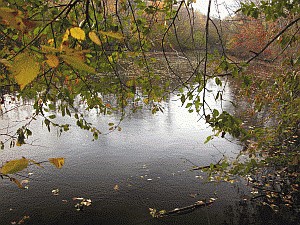Watershed
An Excursion in Four Parts
by Emily Hiestand
revised version of an essay from
Angela the Upside Down Girl and Other Domestic Travels
©1998, ©2005 by Emily Hiestand
Reprinted by permission of Beacon Press, Boston
For more information: www.ehiestand.com
Beacon Press: www.beacon.org
To order Hiestand’s books:
Porter Square Books www.portersquarebooks.com
Amazon.com www.amazon.com
|

Photograph ©2005, Emily Hiestand
|
Full text (Adobe Acrobat file — Get free Adobe Acrobat reader)
Excerpt:
Like travelers who want to keep some favorite place from being discovered, the residents of our neighborhood sometimes confide to one another in a near-whisper, "There's no other place like this in the city." It’s not a grand neighborhood, only a modest enclave on the fringe of the Boston metropolis, but visitors who chance upon our streets are routinely surprised. They remark on the quiet; on the colonnade of maples whose canopies have grown together into a leafy arch over the street; on the many front porches (which older residents call their piazzas), and on the overall sense of being in a little village.
This small urban village is situated in the territory long represented by the late Thomas P. “Tip” O’Neill, who served in the U.S. Congress for thirty-four years, nine of them as Speaker of the House. Our streets are part of his “lunch-bucket liberal” district, a working class neighborhood located on land that formerly held such things as the city's poorhouse, its blacksmith shops, and tanneries. The earliest inhabitants of our streets were predominantly French-Canadians, families and young men fleeing British persecution, streaming south from Nova Scotia, Quebec, and the Iles de la Madeleine. That early history explains why our inland houses and streets feel curiously like a small fishing village; the architecture, exterior stairs and porches, even the way the houses are sited—close to the sidewalks with miniature front yards—are transplants from the maritime villages of Acadia.
|
